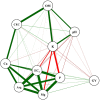Variable-rate in corn sowing for maximizing grain yield
- PMID: 34135455
- PMCID: PMC8208989
- DOI: 10.1038/s41598-021-92238-4
Variable-rate in corn sowing for maximizing grain yield
Abstract
Sowing density is one of the most influential factors affecting corn yield. Here, we tested the hypothesis that, according to soil attributes, maximum corn productivity can be attained by varying the seed population. Specifically, our objectives were to identify the soil attributes that affect grain yield, in order to generate a model to define the optimum sowing rate as a function of the attributes identified, and determine which vegetative growth indices can be used to predict yield most accurately. The experiment was conducted in Chapadão do Céu-GO in 2018 and 2019 at two different locations. Corn was sown as the second crop after the soybean harvest. The hybrids used were AG 8700 PRO3 and FS 401 PW, which have similar characteristics and an average 135-day cropping cycle. Tested sowing rates were 50, 55, 60, and 65 thousand seeds ha-1. Soil attributes evaluated included pH, calcium, magnesium, phosphorus, potassium, organic matter, clay content, cation exchange capacity, and base saturation. Additionally, we measured the correlation between the different vegetative growth indices and yield. Linear correlations were obtained through Pearson's correlation network, followed by path analysis for the selection of cause and effect variables, which formed the decision trees to estimate yield and seeding density. Magnesium and apparent electrical conductivity (ECa) were the most important soil attributes for determining sowing density. Thus, the plant population should be 56,000 plants ha-1 to attain maximum yield at ECa values > 7.44 mS m-1. In addition, the plant population should be 64,800 plants ha-1 at values < 7.44 mS m-1 when magnesium levels are greater than 0.13 g kg-1, and 57,210 plants ha-1 when magnesium content is lower. Trial validation showed that the decision tree effectively predicted optimum plant population under the local experimental conditions, where yield did not significantly differ among populations.
Conflict of interest statement
The authors declare no competing interests.
Figures








References
-
- Mastrodomenico AT, Haegele JW, Seebauer JR, Below FE. Yield stability differs in commercial maize hybrids in response to changes in plant density, nitrogen fertility, and environment. Crop Sci. 2018;58:230. doi: 10.2135/cropsci2017.06.0340. - DOI
-
- Quevedo YM, Beltrán JI, Barragán-Quijano E. Effect of sowing density on yield and profitability of a hybrid corn under tropical conditions. Agron. Colomb. 2018;36:248–256. doi: 10.15446/agron.colomb.v36n3.71268. - DOI
-
- Corrêa RDG, Furlani CEA, Zerbato C, de Oliveira DT, de Oliveira MF. Variation of seed dosage on corn crop production components. J. Agric. Sci. 2018;10:296. doi: 10.5539/jas.v10n8p296. - DOI
-
- Fiorini IVA, Pereira CS, Pereira HD, de Medeiros AL, Pires LPM. Yield and its components according to maize sowing times at offseason in the Northern of Mato Grosso state, Brazil. J. Bioenergy Food Sci. 2018;5:54–65. doi: 10.18067/jbfs.v5i2.195. - DOI
-
- Resende SG, Pinho RGV, Vasconcelos RC. Influência do Espaçamento entre Linhas e da Densidade de Plantio no Desempenho de Cultivares de Milho. Rev. Bras. Milho e Sorgo. 2003;2:34–42. doi: 10.18512/1980-6477/rbms.v2n3p34-42. - DOI
Publication types
LinkOut - more resources
Full Text Sources
Research Materials

